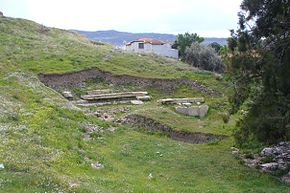Phocaea
| Φώκαια (Greek) Foça (Turkish) |
|

The theatre of Phocaea
|
|
| Alternate name | Phokaia |
|---|---|
| Location | Foça, Izmir Province, Turkey |
| Region | Ionia |
| Coordinates | 38°40′03″N 26°45′29″E / 38.66750°N 26.75806°ECoordinates: 38°40′03″N 26°45′29″E / 38.66750°N 26.75806°E |
| Type | Settlement |
Phocaea, or Phokaia (Greek: Φώκαια; modern-day Foça in Turkey) was an ancient Ionian Greek city on the western coast of Anatolia. Greek colonists from Phocaea founded the colony of Massalia (modern day Marseille, in France) in 600 BC, Emporion (modern day Empúries, in Catalonia, Spain) in 575 BC and Elea (modern day Velia, in Campania, Italy) in 540 BC.
Phocaea was the northernmost of the Ionian cities, on the boundary with Aeolis. It was located near the mouth of the river Hermus (now Gediz), and situated on the coast of the peninsula separating the Gulf of Cyme to the north, named for the largest of the Aeolian cities, and the Gulf of Smyrna (now İzmir) to the south.
Phocaea had two natural harbours within close range of the settlement, both containing a number of small islands. Phocaea's harbours allowed it to develop a thriving seafaring economy, and to become a great naval power, which greatly influenced its culture.
Recent archaeological surveys have shown that the city of Phocaea was large for the archaic period. Herodotus gives an idea of the size of Phocaea by describing the walls of Phocaea as having a length of several stadia.
A 4th century BC Persian Tomb, known as Tas Kule (rock tower), stands (38 39' 37" N, 26 49' 2" E) 7 km east of Phocaea along a main road. This funerary monument was carved out of solid rock with a lower 2.7 meter high rectangular story (9 × 6 meters) surmounted by a second 1.9 meter high story (3 × 3 meters). Four steps between the two levels suggest strong Persian influence and most archaeologists believe this tomb was built for a Persian aristocrat or local leader serving the Persians. Compare the style of the tomb of Cyrus the Great.
...
Wikipedia

